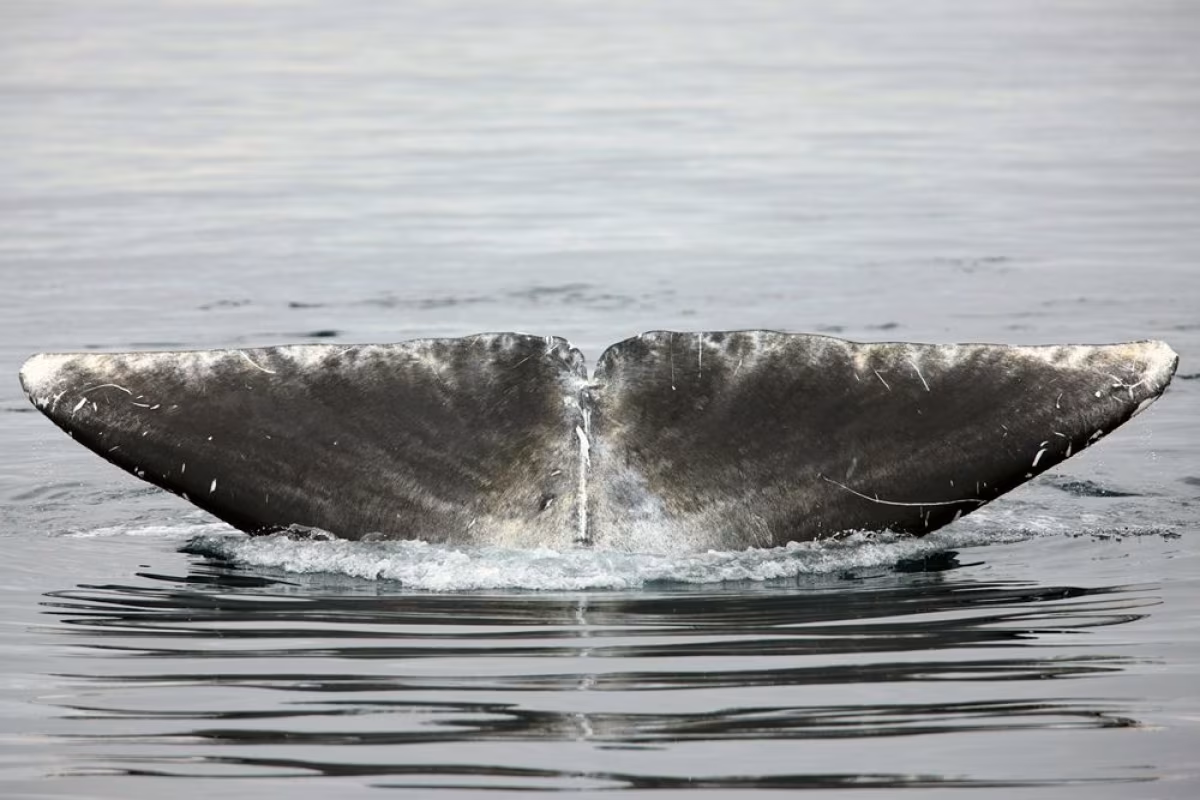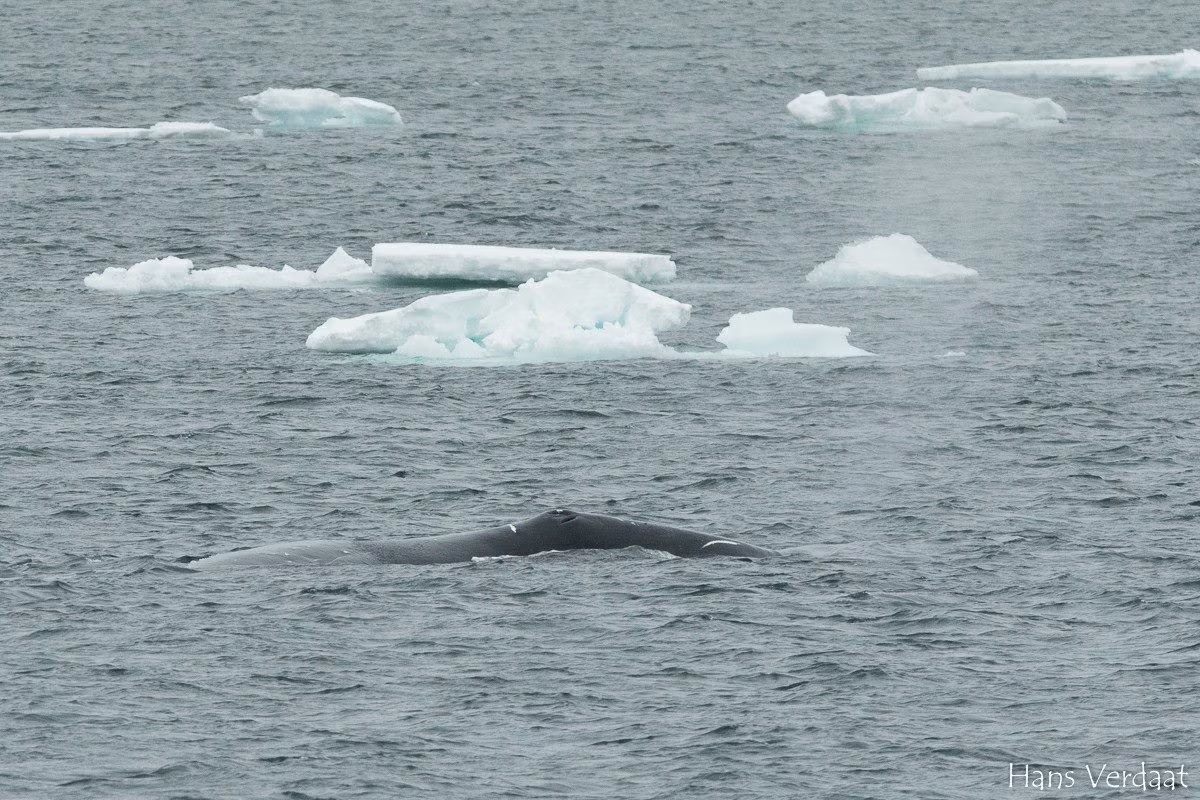Bowhead whales are only found in the cold Northern Hemisphere waters around the Arctic. They are large species that can be up to almost 20 metres long with enormous heads that are around a third of the total body length of adult whales. The species can weigh from anywhere from 75 right up to 100 tonnes.
Bowhead whales are also commonly known as Greenland whales however, because they spend their time in the cold, frigid waters of the Arctic and spend a lot of time below ice and water – unlike other whales that like to migrate to low latitude waters to feed or reproduce. As such, they are difficult for scientists to study.
They are thought to have excellent hearing, a good quality when a lot of the time is spent in dark ocean environments where vision is less useful. They are a highly vocal species that have a large repertoire of calls and song, of which the echoes of these calls can be used to help them navigate through the ice as the migrate seasonally between summer feeing areas and wintering areas.

Bowheads grazing across the ocean
The bowhead whale generally stays around pack ice, often in shallow waters with bowheads commonly found North of Europe, between Canada and Greenland, in the Hudson Bay area, the Okhotsk Sea and the Bering, Chukchi and Beaufort seas. In these waters, they filter food through their large baleen plates. In fact, the whales are known to open their large mouths and graze along the surface, in the water column or on the sea floor.
Bowheads typically eat zooplankton including copepods and small shrimp-like species of euphausiids: tiny creatures that are only 1-3 mm long. The bowhead’s grazing ability is staggering with the typical whale eating around 100 metric tonnes of crustaceans per annum.

Super-long-living whales
The bowhead whale is thought to be very long living with estimates put at 200 years, making it one of the longest-living mammals on Earth. Of medical interest is that bowheads generally stay very healthy and disease-free until much more advanced ages that humans can. While the secrets as to their longevity and resistance to age-related diseases are unknown, scientists do believe they possess aging prevention mechanisms.
To investigate more scientists from the Integrative Genomics of Ageing Group at the University of Liverpool is analysing the bowhead whales’ genome to identify promising candidate genes and mechanisms that may shed light on how these whales live for so long and remain healthy all the way through. By identifying novel maintenance and repair mechanisms researchers then can apply this knowledge to improve human health and even preserve human life.
Bowhead whale numbers healthy
While bowhead whale numbers are not as high as we would like them to be their numbers have increased significantly particularly in Alaska, which is where 90 percent of the world’s entire population of bowhead whales. It is now estimated that in Alaskan waters there are about 10,000 animals and growing.
In fact, the population in these waters has been growing at a healthy 3.5 percent a year, a statistic that is courtesy of marine mammal biologists working with Alaska Natives in the Arctic in the conducting of an annual census of the whales during their spring migration past Point Barrow. To record this data, scientists use a series of hydrophones to monitor the whales underwater.
This acoustical data, combined with air and shore-based observations, indicates the number of bowhead whales in Alaska waters has tripled over the past 30 years. This is culturally important to Alaska Natives who harvest bowheads on a subsistence basis. To ensure this is sustainable, biologists assign a harvest quota intended to maintain population growth while allowing for some subsistence whaling each year.
Surveying bowheads from the sky
In Alaska, inter-agency agreements have been created between the Bureau of Ocean Energy Management (BOEM), Department of Interior and many other agencies to provide funding for bowhead whale aerial surveys, officially known as the Bowhead Whale Aerial Survey Project. The goal is to document the distribution and relative abundance of bowhead as well as other whales.
The programme specifically gathers data on: the annual migration of bowhead whales across the Alaskan Arctic – significant inter year differences and long-term trends in the start and duration of the migration; relative abundance, spatial and temporal distribution and behaviour of the whales and other species; provide real-time maps on marine mammals in the Alaskan Arctic.
In a recent report on bowhead numbers from BOEM, which came during a summer and fall survey during 2014 – a year that sea ice cover was generally light compared with historical sea ice cover – the scientists recorded nearly 600 sightings of 1,200 Bowhead whales. The survey, conducted over 440 hours and covering more than 110,000 km, also sighted over 500 gray whales as well as humpback whales.

Surveying bowheads from space
As part of monitoring bowhead whales, the Bowhead Whale Research project in Alaska has been conducting over the past several years’ satellite tracking of Western Arctic Bowhead whales. Working with subsistence whalers, the project involves attaching satellite transmitters to bowheads to study their movements, habitat use and behaviour throughout their range including migration routes and timing, feeding areas, diving behaviour and time spend within the summer and spring ranges.
The study is also investigating the use of tags that record oceanographic information to identify ocean features such as fronts where whales prefer to feed. The project is additionally developing an acoustic tag that will record ambient sound and the vocal behaviour of the whales to better understand the effects of human-related activities.
Drones hovering over bowhead whales
© LGL Limited, the University of British Columbia, VDOS Global, Fisheries and Oceans Canada and WWF-Canada
Meanwhile drone footage of bowhead whales made international news this year as part an intensive research study conducted by the University of British Columbia. Using drone technology, the team captured rare high-quality images and videos of Eastern Canada-West Greenland bowhead whales during their summer feeding period in Cumberland Sound, Nunavut, which is just near the Arctic Circle.
According to PhD candidate Sarah Fortune, what we know today about bowhead whales comes from boat-based or aerial observations from small planes. However, with drone technology and the clear water in Cumberland Sound, the scientists can observe their behaviour underwater. This will give critical insights in the bowhead’s feeding and social activities.
With the drones providing safe, affordable method of obtaining aerial images and videos without disturbing them in their natural habitat, the research team and local community members could observe their behaviour in real-time: something that was not possible with conventional tagging methods and boat-based observations.
Discovering new behaviours
Scientists already knew these whales travelled in small groups but they did not know that often swam in coordinated patterns, constantly touching or rubbing one another. One of the interesting observations made was that they found the whales to spend their early morning feeding in deep water before resting, often in large groups, in shallow coastal water during the afternoon.
Furthermore, the research took thousands of images that will be used to determine population size (using individual markings), age-structure and body condition. This will provide scientists with essential information on the population’s status and health over time.

